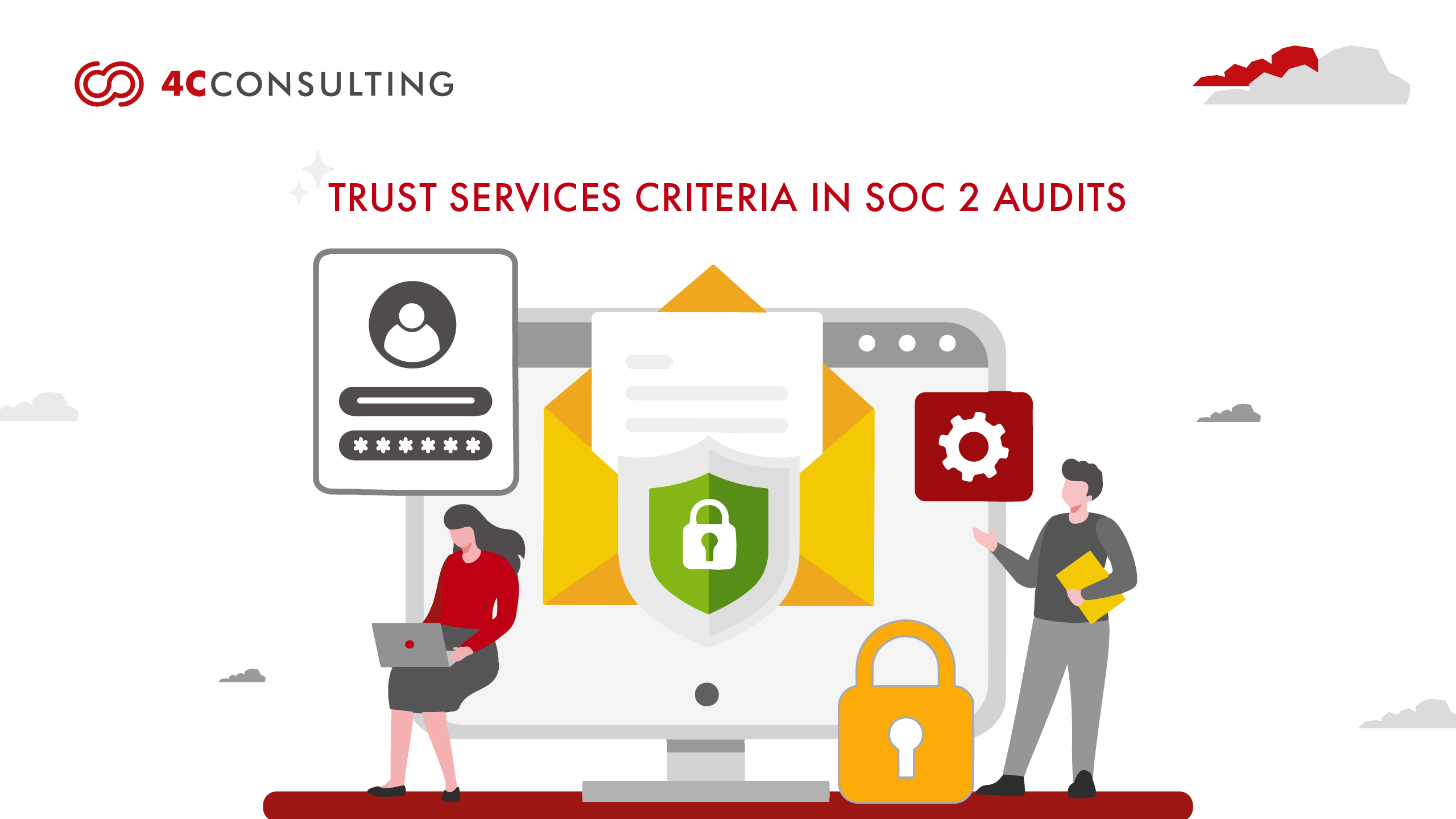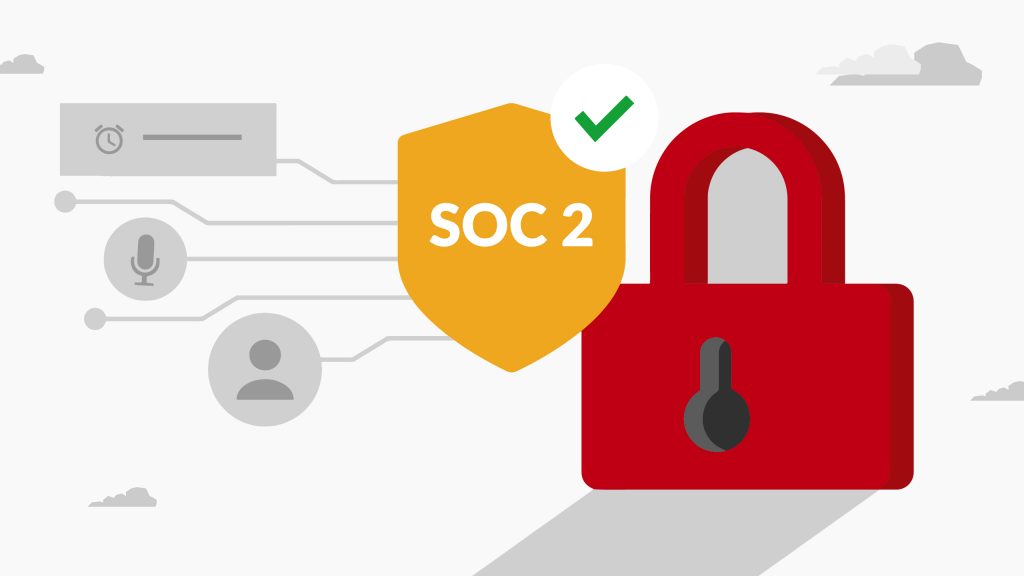
TRUST SERVICES CRITERIA IN SOC 2 AUDITS: A SAAS COMPLIANCE GUIDE
16th Apr, 2025
SOC 2 compliance is now a strategic requirement for SaaS companies, cloud service providers, and digital businesses aiming to earn client trust and scale securely. Built around five Trust Services Criteria—Security, Availability, Processing Integrity, Confidentiality, and Privacy—SOC 2 helps demonstrate that your organization manages data responsibly and meets stringent audit standards. Whether pursuing SOC 2 Type 1 or Type 2 certification, aligning internal controls with these principles is key to protecting customer information, ensuring service reliability, and reducing compliance risk. This blog explores each trust criterion in depth, explains their role in SOC 2 audits, and provides a practical roadmap for SaaS organizations to achieve and maintain SOC 2 compliance while strengthening their cloud security and governance posture.
.
WHAT IS SOC 2 COMPLIANCE?
SOC 2 is a widely recognized auditing framework developed by the American Institute of Certified Public Accountants (AICPA). It assesses the design and operational effectiveness of internal controls relevant to data security and privacy. SOC 2 is most applicable to SaaS providers, data processors, and service organizations that store or manage customer data. SOC 2 reports are categorized into two types:
- SOC 2 Type 1 evaluates the design of controls at a specific point in time.
- SOC 2 Type 2 evaluates the operational effectiveness of controls over a period (usually 3–12 months).
Being SOC 2 compliant provides your customers with verified proof that you’ve implemented adequate controls for system security, integrity, and confidentiality. It’s a crucial step in winning client trust, satisfying procurement requirements, and scaling responsibly.
Start your journey toward trust and transparency—explore our detailed SOC 2 Certification Services tailored for cloud-native and SaaS businesses.
.
UNDERSTANDING THE TRUST SERVICES CRITERIA:
The Trust Services Criteria (TSC) are the framework on which every SOC 2 report is built. These five principles define the core controls your organization should follow to protect data and deliver secure services:
- Security (Mandatory for all SOC 2 audits)
- Availability
- Processing Integrity
- Confidentiality
- Privacy
The first criterion Security, is required for all SOC 2 reports. The remaining four are optional and based on the nature of your services and customer expectations. For example, a company offering medical record management software may include Privacy and Confidentiality, while a customer-facing CRM provider might focus on Availability and Processing Integrity.
.
DETAILED BREAKDOWN OF THE FIVE TRUST SERVICES CRITERIA:
1. Security: Protecting Systems Against Unauthorized Access
Security is the cornerstone of SOC 2 audits, forming the baseline requirement for all organizations seeking SOC 2 compliance. It encompasses preventive, detective, and corrective controls to protect systems from unauthorized access—both internal and external. This includes managing user authentication, implementing encryption protocols, securing physical facilities, and maintaining systems that detect and respond to potential threats. Typical controls include:
- Firewalls and intrusion detection systems (IDS)
- Secure coding and patch management
- Role-based access controls (RBAC)
- Multi-factor authentication (MFA)
- Vulnerability scanning and penetration testing
Meeting the security criterion requires companies to develop a culture of cyber security awareness and resilience. A robust incident response plan is essential, ensuring any breaches are handled swiftly with minimal disruption. Audit trails, log monitoring, and employee access controls serve as foundational pillars. By enforcing these best practices, organizations can deter malicious actors and reassure clients that their data is in safe hands. In today’s hybrid cloud and remote work environments, dynamic security frameworks such as Zero Trust Architecture are also encouraged to reduce risk exposure across endpoints.
2. Availability: Ensuring System Uptime and Reliability
Availability refers to whether the organization’s systems remain accessible and functional according to its commitments with clients. This trust criterion evaluates the performance of IT infrastructure, redundancy systems, disaster recovery, and capacity planning. The goal is to ensure that services continue without interruption, even in the face of incidents or high usage volumes. Key controls may include:
- Load balancing and failover infrastructure
- Disaster recovery (DR) and business continuity (BC) planning
- System monitoring and performance alerting
- SLA tracking and uptime reporting
- Regular testing of backup systems
For SaaS companies, where downtime directly impacts customer experience, meeting the availability criterion is a non-negotiable priority. Maintaining consistent system uptime enhances business credibility and minimizes financial and reputational loss. Automation tools that monitor server health and alert teams about unusual behaviors also play a critical role in achieving SOC 2 compliance. Clients want assurance that your platform is available when they need it, without disruptions.
3. Processing Integrity: Accuracy and Timeliness of System Processing
Processing Integrity relates to the completeness, validity, accuracy, timeliness, and authorization of data processing. This criterion ensures that data transactions are properly recorded, processed as intended, and delivered reliably to the end-user or system. The goal is to prevent any accidental or unauthorized changes that could affect business logic or user outcomes. Controls to support this include:
- Data input validation and checksums
- Logging for automated tasks and workflows
- System alerts for failed processes
- Reconciliation procedures for processed data
- Version control and approval for business rules
This is especially critical for businesses that manage complex financial transactions, healthcare systems, CRM platforms, or logistics operations. A single error in processing can lead to downstream consequences, from compliance violations to customer loss. Demonstrating integrity in processing reassures stakeholders that your platform operates with precision and reliability.
4. Confidentiality: Protection of Sensitive Internal Data
Confidentiality focuses on safeguarding information designated as confidential. This includes intellectual property, business plans, customer data, and any non-public organizational assets that must remain protected. The criterion requires that only authorized personnel can access, use, or disclose such information, and that safeguards are in place to prevent leakage. Relevant controls include:
- Data encryption (at rest and in transit)
- Role-based access permissions
- Document classification and access controls
- Secure transmission methods (e.g., VPNs, TLS)
- Confidentiality agreements with staff and third parties
Companies working with enterprise clients, government contracts, or high-value proprietary tools need to ensure confidentiality is not compromised. SOC 2 audits validate how well data is stored, shared, and disposed of. Additionally, granular access control systems must be supported with policy documentation and regular audits. Maintaining confidentiality preserves trust and competitive advantage.
5. Privacy: Protection of Personal Data According to Legal Requirements
Privacy is centered around the organization’s ability to handle personal data in compliance with regulatory standards like GDPR, CCPA, and HIPAA. It governs how data is collected, used, retained, and disposed of, and it focuses on an individual’s right to control their information. Controls supporting privacy compliance include:
- Consent and opt-in management
- Data minimization and retention policies
- Breach notification procedures
- Data subject rights (DSR) request handling
- Third-party risk management for shared PII.
Organizations that handle user data directly—such as health tech, ed-tech, e-commerce, or fintech platforms—must show clear policies and systems that protect privacy. Regular training, third-party assessments, and transparency measures go a long way in ensuring compliance. Incorporating privacy into your SOC 2 audit also signals that you respect your users’ rights and build products with a privacy-first mindset. Together, these five Trust Services Criteria form the backbone of SOC 2 compliance, offering a structured approach to secure system design and operation. Addressing each criterion comprehensively allows organizations to not only meet audit expectations but also improve customer confidence, attract enterprise contracts, and demonstrate operational maturity in the cloud-based era.

Need expert help? Our consultants are ready to guide you—Contact 4C Consulting for a personalized SOC 2 readiness strategy.
.
WHY ARE THESE CRITERIA IMPORTANT IN SOC 2 AUDITS?
The five Trust Services Criteria are not just audit checkboxes—they form the backbone of a secure and responsible service organization. For SaaS providers, cloud platforms, and data processors, these criteria establish industry-accepted benchmarks to demonstrate your ability to manage data responsibly. In SOC 2 audits, auditors assess how well your business meets each of these principles, not only in theory but in practice. They measure your maturity in protecting data, sustaining operations, maintaining integrity, and respecting privacy. Implementing these criteria also reflects a proactive culture of trust and reliability that customers and partners look for before signing contracts or integrating services.
- Builds Customer Confidence: SOC 2 compliance signals that your company takes security and privacy seriously. This transparency builds trust with customers, especially enterprise clients, and helps you stand out in RFPs and vendor assessments. It shows you’re prepared to protect their data and maintain accountability. In competitive SaaS markets, demonstrating trustworthiness often becomes the deciding factor in vendor selection. It also enhances brand image and long-term client relationships.
- Reduces Risk of Breaches: Each Trust Services Criterion—especially Security and Confidentiality—helps your team proactively prevent data breaches, insider threats, and system failures. Controls like encryption, access management, and security monitoring provide a defence-in-depth approach. They reduce attack surfaces and ensure faster detection and resolution of issues. Regular vulnerability assessments and incident response planning are key to meeting this criterion effectively. Organizations with strong breach mitigation frameworks are more resilient during crises.
- Supports Legal Compliance: Data privacy and cyber security laws are becoming more stringent across the globe. Criteria like Privacy help you stay compliant with evolving regulations such as GDPR, CCPA, and HIPAA. Instead of scrambling during a legal review or regulatory audit, SOC 2-aligned organizations have policies and systems already in place. This saves time and effort, reduces penalties, and ensures consistent readiness for evolving legal obligations. It also facilitates smoother collaboration with external legal teams and regulators during compliance checks. Staying compliant boosts investor confidence and readiness for global expansion.
- Improves Internal Operations: SOC 2 audits often expose gaps in documentation, workflows, or team responsibilities. Addressing these through the lens of the Trust Criteria improves cross-team coordination and process maturity. Clear security policies, defined access control processes, and consistent monitoring improve operational hygiene. It brings IT, InfoSec, HR, legal, and product teams into better alignment, reducing miscommunication and enabling faster decision-making. SOPs and training programs become more structured, ensuring process consistency. This also leads to better onboarding and reduced human error.
- Enables Secure Growth: As your user base, team, or infrastructure scales, risks multiply—especially in SaaS and multi-tenant environments. The Trust Criteria ensure that your controls evolve with your growth. This includes scalable access management, data integrity, high availability, and role-based permissions. Having these pillars in place gives you confidence to expand into new markets or serve enterprise clients without compromising security or reliability. Growth is supported by automated controls and real-time monitoring. This makes your systems more agile and audit-ready as you scale.
- Simplifies Future Audits: SOC 2 isn’t a one-time checkbox—it’s a continuous cycle. By building systems aligned with the Trust Criteria, your business sets up reusable controls, automated logging, and documented policies that make subsequent audits faster and smoother. You’ll spend less time on audit prep and more time on innovation. This also reduces dependency on expensive consultants and shortens sales cycles with clients requiring proof of compliance. Over time, your audit readiness becomes part of your daily operations. Internal teams gain clarity on expectations, reducing audit fatigue.
- Keeps You Future-Ready: Tech, threats, and regulations evolve quickly. The Trust Criteria aren’t static—they’re designed to evolve too. By adopting them early and thoroughly, your future-proof your systems for upcoming standards and client expectations. Whether it’s adapting to AI regulation, zero-trust security models, or stricter data residency laws, SOC 2-aligned companies are better positioned to pivot and scale with confidence. Anticipating future trends enhances your strategic planning. Being future-ready ensures smoother transitions during M&A, funding, or global expansion.
Want to dive deeper into how SOC 2 compliance works in real-world audits? Read our full SOC 2 Compliance Blog to learn more.
.
How Organizations Can Prepare for SOC 2 with These Criteria:
Preparing for SOC 2 compliance requires a holistic commitment to data protection, internal discipline, and continual improvement. Organizations, especially in the SaaS and cloud services sector, must treat SOC 2 as a strategic initiative to build stakeholder trust, secure customer data, and ensure operational excellence. From implementing security frameworks to documenting every process, companies must align their internal controls with the five Trust Services Criteria. The audit process examines your real-world operations—not just written policies—so being proactive, thorough, and consistent is essential. Here are seven key strategies that help SaaS businesses prepare effectively and become SOC 2 compliant.
- Conduct a SOC 2 Readiness Assessment: A readiness assessment is the first step to evaluate your organization’s current standing against SOC 2 requirements. It identifies compliance gaps across Security, Availability, Processing Integrity, Confidentiality, and Privacy. This diagnostic phase highlights which controls are already in place, which need improvements, and what’s missing altogether. Many SaaS companies partner with consultants or use SOC 2 checklists to streamline this process. A clear roadmap created during this phase ensures smoother implementation and minimizes surprises during the actual SOC 2 audit.
- Build and Document Internal Policies & Procedures: Documented policies are the backbone of your SOC 2 audit. Auditors will evaluate how your organization operates in practice and how well your processes are documented and followed. These include access control, data retention, incident response, privacy handling, and vendor risk management. Your documentation must not only exist—it must be accurate, up to date, and reflective of day-to-day activities. For SaaS organizations, well-maintained SOPs increase audit readiness and reinforce organizational discipline.
- Strengthen Access Controls and System Security: Security is the foundation of SOC 2, so start by ensuring role-based access, secure authentication, and endpoint monitoring. Use Multi-Factor Authentication (MFA), RBAC (Role-Based Access Control), firewalls, and intrusion detection systems. Encrypt sensitive data in transit and at rest. Automate user access reviews and create logs that track login activities. These controls demonstrate that your system can prevent unauthorized access—one of the key requirements for SOC 2 compliance, especially under the Security criterion.
- Implement Real-Time Monitoring & Regular Testing: SOC 2 requires continuous monitoring of your systems to ensure performance, integrity, and availability. Use automated tools to monitor system uptime, performance metrics, failed logins, and data anomalies. Run regular disaster recovery and business continuity simulations. For SaaS firms, system availability and processing integrity are business-critical—downtime impacts not only users but your credibility. Real-time alerts and root cause analysis also contribute to long-term system reliability and faster audit preparation.
- Invest in Employee Awareness and Security Training: Your people play a vital role in SOC 2 compliance. Even with strong technical controls, human error can result in breaches or compliance failures. Regularly train employees on security best practices, password hygiene, email phishing, and incident response protocols. Ensure staff are aware of their responsibilities regarding sensitive data, especially in hybrid or remote work models. Training logs and quizzes not only foster a compliance culture—they also serve as evidence during audits.
- Strengthen Vendor Risk Management: SOC 2 auditors assess how you manage vendors and external partners, especially those with access to your systems or customer data. Evaluate each vendor’s compliance posture, add data protection clauses in contracts, and request third-party audit reports. Set up periodic vendor risk reviews and tracking mechanisms. For SaaS companies using third-party APIs or cloud platforms, strong vendor oversight is essential to avoid supply chain vulnerabilities that can derail compliance.
- Automate Compliance Workflows & Audit Preparation: Manual tracking of compliance tasks can be error-prone and inefficient. Use GRC (Governance, Risk & Compliance) tools to automate policy reviews, evidence collection, ticketing for non-conformities, and compliance reporting. Automating audit readiness ensures repeatability, reduces administrative load, and improves accuracy during audits.
Looking to enhance your information security posture? Explore 4C’s proven ISO & Management System Consulting Services for scalable, audit-ready solutions.
SOC 2 compliance has become a critical requirement for SaaS companies and cloud-based service providers. By aligning with the five Trust Services Criteria—Security, Availability, Processing Integrity, Confidentiality, and Privacy—organizations can build trust, ensure legal compliance, and protect customer data. Whether pursuing SOC 2 Type 1 or Type 2 certification, these criteria help create stronger internal controls, reduce risks, and meet client expectations. A solid SOC 2 compliance checklist also prepares companies for smoother audits and future scalability. As the demand for secure SaaS architecture and data privacy grows, implementing these controls is essential for long-term success. SOC 2 certification isn’t just about passing an audit—it’s about proving you’re a secure, reliable, and future-ready service provider.
.
HOW 4C CAN HELP YOUR ORGANIZATION IN SOC 2 COMPLIANCE CERTIFICATION?
4C aids your organization in building credibility and trust with clients, employees, and stakeholders while reaping the benefits of SOC 2 compliance. Our experts provide complete SOC 2 implementation support, including training and consulting. Our IRCA-certified auditors, boasting 15+ years of experience, have assisted over 100 IT and ITES companies with risk assessment and continuity planning. Through our services, companies globally have bolstered profitability and credibility. With a proven track record of 5000+ training hours in IT Security Management System (ISMS), we enable continual benefits. To embrace ISO standards and achieve SOC 2 compliance seamlessly
Discover how we help fast-scaling SaaS companies meet trust standards and secure client data—Book a free consultation today.
.
Frequently asked questions:
.
1. What are the common criteria for SOC 2?
The common criteria for SOC 2 refer to the five Trust Services Criteria developed by the AICPA. These include Security, Availability, Processing Integrity, Confidentiality, and Privacy. Every SOC 2 audit must include the Security criterion, while the remaining criteria are selected based on the organization’s services and risk profile.
2. What are SOC 2 requirements?
SOC 2 requirements include establishing and operating internal controls that align with the selected Trust Services Criteria. These controls must cover areas such as access management, incident response, data encryption, system availability, and privacy handling. To become SOC 2 compliant, organizations must undergo an external audit by a licensed CPA or firm.
3. What are the 5 trust criteria for SOC 2?
The five Trust Services Criteria for SOC 2 are:
- Security – Protecting systems against unauthorized access
- Availability – Ensuring systems are operational and reliable
- Processing Integrity – Ensuring data is processed accurately and on time
- Confidentiality – Safeguarding sensitive business and client information
- Privacy – Managing personal data in accordance with laws like GDPR and CCPA
These criteria form the foundation of any SOC 2 compliance audit.
4. What does SOC 2 mean?
SOC 2 stands for System and Organization Controls 2. It is a framework developed by the AICPA to evaluate how service providers manage customer data, particularly in cloud and SaaS environments. A SOC 2 report provides assurance that an organization has implemented appropriate controls around data security, availability, and privacy.
5. What is SOC level 2?
SOC Level 2, commonly referred to as SOC 2 Type 2, evaluates how well an organization’s controls operate over a period of time—usually between 3 to 12 months. It differs from SOC 2 Type 1, which only assesses control design at a specific point in time. SOC 2 Type 2 offers a deeper view into the operational effectiveness of controls.
6. What are the 5 principles of SOC 2?
The 5 principles of SOC 2, also called the Trust Services Criteria, are:
- Security
- Availability
- Processing Integrity
- Confidentiality
- Privacy
These principles help organizations build secure, resilient, and trustworthy systems and are at the core of any SOC 2 audit.
7. What is the difference between SOC 1 and SOC 2?
SOC 1 and SOC 2 are both attestation reports, but they differ in their focus. SOC 1 focuses on financial controls, while SOC 2 focuses on information security and privacy controls.
8. How do I get a SOC 2 audit?
To obtain a SOC 2 audit, first determine whether a Type I or Type II report is appropriate for your organization. Define the scope based on relevant Trust Services Criteria, conduct a readiness assessment to address any gaps, and implement necessary controls. Engage a licensed CPA firm to perform the audit. Upon completion, you will receive a formal SOC 2 report demonstrating your organization’s commitment to data security and compliance.
9. What is a SOC2 certification?
SOC 2 certification is a third-party audit that verifies a company’s controls for managing customer data securely, based on AICPA’s Trust Services Criteria. It’s widely used by tech and cloud service providers to build trust and show compliance.
10. Is ISO 27001 the same as SOC2?
ISO 27001 and SOC 2 are not the same, but both focus on information security.
ISO 27001 is an international standard for establishing and maintaining an Information Security Management System (ISMS). It’s certifiable and applies globally.
SOC 2 is a U.S.-based attestation report (not a certification) that evaluates how a service provider manages data based on specific Trust Services Criteria.
